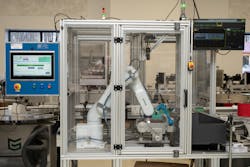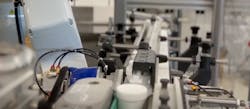Medical Cannabis Supplier Automates Labeling
Robots are no longer a tool reserved for the largest industrial companies, as evidenced by SunMed Growers, a Maryland-based medical cannabis grower. In its 300,000-sq.-ft. facility, which employs 150 people, SunMed Growers eliminated several manual tasks associated with its packaging and labeling operations using Epson robotic and labeling technologies.
Working with systems integrator Integrated Productivity Systems (IPSi), SunMed Growers implemented a flexible robotic print-and-apply system centered around an Epson ColorWorks industrial, on-demand color label printer and Epson’s VT6L six-axis robot.
“People tend to think automation is suited only for manufacturing environments with high volume and high labor costs because it is out of reach for most businesses financially,” said Rick Schilling, owner of IPSi. “That is just not the case. The true benefit of automation is the ability to control processes, which is what SunMed was able to do by implementing the new system while also keeping cost in mind.”
Automated packaging and labeling
The process of packaging SunMed Growers’ most popular products involves the production of two to four batches per day with each batch size requiring between 2,000-3,000 labels.
Prior to implementation of the automated labeling system, SunMed Growers printed labels offline and used a rewinder to rewind labels onto a core. They then had a team manually apply the labels with a semi-automatic labeling system.
With such heavily manual operations, Jordane Fairchild, post-harvest manager at SunMed Growers, said the company experienced issues such as producing entire batches of labels with errors before any errors were detected. Such issues caused Fairchild to frequently be “worried that I accidentally sent labels with the wrong lot number.”
The Epson VT6L robot features a 900mm reach and can handle payloads up to 6kg. The robot comes with a built-in controller and software for less than $15,000. Cleanroom ISO Class 4, IP67-rated, and 48V DC-powered mobile versions are also available.
Changed operations
Looking back on the labeling process before and after installation of the automated system, Fairchild said, “Before, we could run four batches by lunchtime and it would take the rest of the day to label them. Now, when we run a batch, all are packaged, labeled, and finished in one pass. It cut the amount of work time in half.”
“As with any new business, things change quickly,” said Schilling. “The feedback SunMed Growers got from the field and from their salespeople would prompt changes in packaging—and the minute the packaging changes, it creates a lot of complexity around label printing. This is the first machine I'm aware of that prints and applies labels on-demand and in color and is set up for next label out, which means that every label could be different.”
Schilling noted that SunMed Growers currently serializes at the batch level. But this automated system can deliver individual serialized containers, he added.
About the Author
David Greenfield, editor in chief
Editor in Chief

Leaders relevant to this article:



